It was another heritage hunting expedition for me, this time in Bicol. Since we wanted to include reresentative municipios from Bicol in the 2007 HCS calendar, I went there to check out the Tabaco City Hall among others. Anyway, I took the Philtranco bus that left Pasay at 8 p.m. The usual ride to Bicol would take 10 hours. But the roads in southern Quezon were just horrible so that delayed us by close to two hours (yes, the roads were that bad). And I arrived in Legazpi City close to 8 a.m.I was met at the Legazpi Central Terminal by the staff of the provincial tourism office. Gemma had made arrangements with the governor for them to take me around Albay to search for heritage structures. After a brief stop at the office to meet with the provincial tourism officer, and at the Government Guesthouse to freshen up and drop off my stuff, we were off.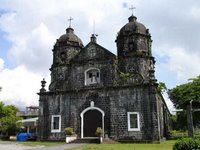 The first stop on the itinerary was the town of Sto. Domingo, the hometown of Sarung Banggi composer Potenciano V. Gregorio. They have a nice church, the Sto. Domingo de Guzman Church, with two symmetrical bell towers on both sides of the facade. This was compeleted sometime in 1832. Sad to say, entering the church was a disappointment, since it was renovated as always. Oh those priests! They like leaving their mark no matter how ugly! It was a pity since the facade was quite charming.In the small plaza in front of the church is a monument to Andres Bonifacio (they say Bonifacio had a girlfriend from the town which is why they built a monument there) and the mausoleum of Potenciano V. Gregorio.
The first stop on the itinerary was the town of Sto. Domingo, the hometown of Sarung Banggi composer Potenciano V. Gregorio. They have a nice church, the Sto. Domingo de Guzman Church, with two symmetrical bell towers on both sides of the facade. This was compeleted sometime in 1832. Sad to say, entering the church was a disappointment, since it was renovated as always. Oh those priests! They like leaving their mark no matter how ugly! It was a pity since the facade was quite charming.In the small plaza in front of the church is a monument to Andres Bonifacio (they say Bonifacio had a girlfriend from the town which is why they built a monument there) and the mausoleum of Potenciano V. Gregorio. From Sto. Domingo, we moved to the next town Bacacay and the Sta. Rosa de Lima Church. Again, this nice church was renovated inside. Sigh! Right beside it were ruins of an older church and one could still recognize some of its features.The next town was Malilipot and its church under the patronage of Our Lady of Mount Carmel. Nice facade but again renovated inside.
From Sto. Domingo, we moved to the next town Bacacay and the Sta. Rosa de Lima Church. Again, this nice church was renovated inside. Sigh! Right beside it were ruins of an older church and one could still recognize some of its features.The next town was Malilipot and its church under the patronage of Our Lady of Mount Carmel. Nice facade but again renovated inside. We were then off to Tabaco City which is home to the only national cultural treasure in Bicol, the San Juan Bautista Church. I wonder why the National Museum even considered this church a national cultural treasure. Except for its massive belfry which I must admit is quite an impressive work of art and engineering, the rest of it has been altered just like every other church I've been to in Albay. I wonder how this trend started. But it was sad entering every church seeing the interiors altered.
We were then off to Tabaco City which is home to the only national cultural treasure in Bicol, the San Juan Bautista Church. I wonder why the National Museum even considered this church a national cultural treasure. Except for its massive belfry which I must admit is quite an impressive work of art and engineering, the rest of it has been altered just like every other church I've been to in Albay. I wonder how this trend started. But it was sad entering every church seeing the interiors altered. The facade of the Tabaco Church itself has new oversized stained glass windows. While the old santos in the retablos have been replaced by new ones. If you were to ask me, the candidates for national cultural treasure in Albay should have been the churches in Daraga or Camalig. Oh well!
The facade of the Tabaco Church itself has new oversized stained glass windows. While the old santos in the retablos have been replaced by new ones. If you were to ask me, the candidates for national cultural treasure in Albay should have been the churches in Daraga or Camalig. Oh well! We then checked out the city hall which I had travelled so far to see. I wasn't quite pleased with what I saw. Indeed, it is the most well-preserved municipio in Albay, but there was so much clutter because of ongoing basketball competitions, the entire perimeter fence was covered with galvanized iron sheets maybe because they charged entrance to the games and with the cover, bystanders could not watch. We were also told it was Spanish colonial. But it turns out, the city hall was built during the American colonial period, very typical of town buildings during that time. Oh well, so much for that calendar photo.The group had lunch in Tabaco and naturally, I had Bicol express among others. What a shame if I did not eat any Bicol express while in Bicol. But the one I had for lunch wasn't that spicy. After lunch, we drove to Malinao but since it was scorching hot and the church wasn't that appealing, I decided not to go down anymore.
We then checked out the city hall which I had travelled so far to see. I wasn't quite pleased with what I saw. Indeed, it is the most well-preserved municipio in Albay, but there was so much clutter because of ongoing basketball competitions, the entire perimeter fence was covered with galvanized iron sheets maybe because they charged entrance to the games and with the cover, bystanders could not watch. We were also told it was Spanish colonial. But it turns out, the city hall was built during the American colonial period, very typical of town buildings during that time. Oh well, so much for that calendar photo.The group had lunch in Tabaco and naturally, I had Bicol express among others. What a shame if I did not eat any Bicol express while in Bicol. But the one I had for lunch wasn't that spicy. After lunch, we drove to Malinao but since it was scorching hot and the church wasn't that appealing, I decided not to go down anymore.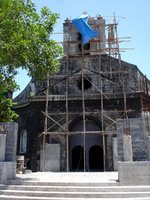 From there it was off to Tiwi. Looking at the pictures, I was expecting a very quaint church. But we got the shock of our lives when we arrived there since it was currently undergoing uglification! They were plastering the adobe with a layer of cement and were beginning to contruct an oversized portico in front of the church which would completely ruin the facade!I immediately texted Archt. Rino Fernandez who heads the Bicol Heritage Program at Aquinas University. He told me that they had already talked to the bishop who agreed that no more old churches would be defaced. They had already stopped construction a month ago but the parish priest is just so hard headed! So they are at it again!
From there it was off to Tiwi. Looking at the pictures, I was expecting a very quaint church. But we got the shock of our lives when we arrived there since it was currently undergoing uglification! They were plastering the adobe with a layer of cement and were beginning to contruct an oversized portico in front of the church which would completely ruin the facade!I immediately texted Archt. Rino Fernandez who heads the Bicol Heritage Program at Aquinas University. He told me that they had already talked to the bishop who agreed that no more old churches would be defaced. They had already stopped construction a month ago but the parish priest is just so hard headed! So they are at it again!
The parish priest is Fr. Jun Barquez and their phone number is (052) 4885187. For crying out loud father, stop wasting church money. You keep on asking donations from the townsfolk for these renovations which are not even needed, for what? So that you could say you left a mark on the church no matter how ugly? I noticed he had a donation box for evangelization, so why not use the money there instead? Sometimes you can't understand the logic of these priests. It's a waste of church money! They seem to like making the contractors happy.Anyway, Tiwi is known for its halo-halo so we stopped over to have some at a place called DJC Halo-halo a few meters from the church. Not bad at all. But the ones we have in Pampanga have richer flavors. I guess I'm just used to those.
 From Tiwi, it was a long drive to Libon which was on the other side of Albay. Nothing much left there, not even an old church, which is a pity because this used to be Villa Santiago de Libon, the fourth villa established by the Spaniards in the archipelago. We then drove to Polangui, Oas and Ligao City. The next stop was Guinobatan. And on the way, we stopped along the road to buy a snack, a very popular delicacy known as macapuno rice puto which was two layers of puto, one purple and one white with a rich macapuno filling in the center. Yummy!
From Tiwi, it was a long drive to Libon which was on the other side of Albay. Nothing much left there, not even an old church, which is a pity because this used to be Villa Santiago de Libon, the fourth villa established by the Spaniards in the archipelago. We then drove to Polangui, Oas and Ligao City. The next stop was Guinobatan. And on the way, we stopped along the road to buy a snack, a very popular delicacy known as macapuno rice puto which was two layers of puto, one purple and one white with a rich macapuno filling in the center. Yummy!
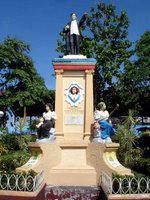 Anyway, Guinobatan struck me because of the colorfully painted municipio, church and monuments, very typical of structures at that time. We just don't realize it because photos are in black and white but facades of buildings during the Spanish and American colonial periods used to be colored quite lively.
Anyway, Guinobatan struck me because of the colorfully painted municipio, church and monuments, very typical of structures at that time. We just don't realize it because photos are in black and white but facades of buildings during the Spanish and American colonial periods used to be colored quite lively.
In Camalig was the San Juan Bautista Church which I consider the best-preserved church in Albay. Even the convento is intact. Completed in 1848, the church has Mount Mayon for a backdrop.
 Inside, the ceiling still has its original murals but sad to say the floor had been raised by over a meter covering the original clay tile floor. The altar also has modern santos. I wonder which house in Forbes Park has most of the centuries-old Albay santos. Hehe!
Inside, the ceiling still has its original murals but sad to say the floor had been raised by over a meter covering the original clay tile floor. The altar also has modern santos. I wonder which house in Forbes Park has most of the centuries-old Albay santos. Hehe!
Our next stop was the Cagsawa Ruins, the most photographed man-made site in the Bicol Region. The place offered you one of the best views of Mount Mayon.
 Seeing majestic Mayon even for the second time was most worth the long hours on the road. Its nearly perfect cone towers over the landscape in Albay and is a part of life there. I hope the Bicolanos are able to maintain the beauty of their natural heritage, especially Mayon, because indeed, these are treasures.
Seeing majestic Mayon even for the second time was most worth the long hours on the road. Its nearly perfect cone towers over the landscape in Albay and is a part of life there. I hope the Bicolanos are able to maintain the beauty of their natural heritage, especially Mayon, because indeed, these are treasures.
From Cagsawa, it was off to the second most photographed man-made site in Bicol, the Our Lady of the Gate Church in Daraga which is perched on top of a hill overlooking Mayon Volcano and the plains below.
 Daraga Church is indeed a sight to behold with its very elaborate facade. As I mentioned earlier, if there should have been a national cultural treasure, it should be this church with its elaborately-decorated facade. But the interior is as modern as it can get an this may explain why the National Museum no longer considered the church. Only the baptistry (below) has remnants of the previous interior and you can see from the carvings on the wall, the remaining patches of paint, and the blue ceramic tiles on the floor that the inside was equally elaborate as well.
Daraga Church is indeed a sight to behold with its very elaborate facade. As I mentioned earlier, if there should have been a national cultural treasure, it should be this church with its elaborately-decorated facade. But the interior is as modern as it can get an this may explain why the National Museum no longer considered the church. Only the baptistry (below) has remnants of the previous interior and you can see from the carvings on the wall, the remaining patches of paint, and the blue ceramic tiles on the floor that the inside was equally elaborate as well.
 We were told that a former parish priest had the interior renovated and even sold many of the priceless antiques to fund the said uglification. Horrible this priests who leave a mark by wasting church money, selling off priceless works of art which end up in private homes most of the time to pay for useless and ugly renovations so that they will be remembered.
We were told that a former parish priest had the interior renovated and even sold many of the priceless antiques to fund the said uglification. Horrible this priests who leave a mark by wasting church money, selling off priceless works of art which end up in private homes most of the time to pay for useless and ugly renovations so that they will be remembered.
From Daraga, it was back to Legazpi City where I took photos of the Cathedral and the Bicol University elemetary and high school Gabaldon buildings (below) which were almost identical to each other. Gemma had asked me to survey it since the high school principal had visited her in Manila that morning (what a coincidence) hoping to ask help in restoring the building since it was quite dilapidated.
 It was 5 p.m. and I realized I had visited almost every town in Albay in a span of nine hours! I had enough for the day and it was back to the guesthouse. After a brief nap, I took a jeep to the center of the Old Albay District (downtown Legazpi is called the Port District) to have some dinner. I could not resist the isaw which was sold all over the place. Again, I had Bicol express. But this time, it was spicy! After checking mail, it was off to bed since I was tired and I had a long day ahead of me tomorrow.
It was 5 p.m. and I realized I had visited almost every town in Albay in a span of nine hours! I had enough for the day and it was back to the guesthouse. After a brief nap, I took a jeep to the center of the Old Albay District (downtown Legazpi is called the Port District) to have some dinner. I could not resist the isaw which was sold all over the place. Again, I had Bicol express. But this time, it was spicy! After checking mail, it was off to bed since I was tired and I had a long day ahead of me tomorrow.
Unlike most of you who enjoyed the long weekend, I had to attend some official activites connected to the occassion. Not that I'm complaining because I like attending these activities which commemorate the declaration of Philippine independence. For the eve of Independence Day, I was invited by the Secretary of Tourism to watch Hinabing Gunita, the Independence Day presentation at the Cultural Center of the Philippines.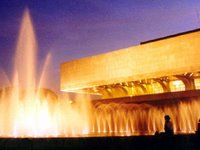 The CCP Main Theater is indeed a sight to behold especially in the evenings with the fountains turned on. A creation of National Artist for Architecture Leandro Locsin, the CCP Complex was the envy of our neighbors when in was newly-constructed. They don't make government buildings like those in the Philippines nowadays, grandiose, elegant and tastefully done. Today, the DPWH and other government agencies charged with construction churn out the ugliest buildings in the world! Four walls and a roof and the rest goes to someone's pockets! Sigh! When will this country start thinking big again?The invitation called for formal Filipiniana attire. Which is why I was so disappointed when I saw a large number of the audience came in semi-formal attire fit for an ordinary day in the office, many even in crew neck t-shirts and maong. Earth to whoever you guys are, you are attending an Independence Day program! Isn't it obvious that the occasion calls for all of us to don our native costumes and be proud of wearing Filipino formal wear just this once?! And we were in the Cultural Center of the Philippines for crying out loud! Plus there were members of the Diplomatic Corps and other important people in attendance. Moreover, it was a gala performance and yet there was a sizeable number of people in clothes fit for the shopping mall or a movie house. Duh!
The CCP Main Theater is indeed a sight to behold especially in the evenings with the fountains turned on. A creation of National Artist for Architecture Leandro Locsin, the CCP Complex was the envy of our neighbors when in was newly-constructed. They don't make government buildings like those in the Philippines nowadays, grandiose, elegant and tastefully done. Today, the DPWH and other government agencies charged with construction churn out the ugliest buildings in the world! Four walls and a roof and the rest goes to someone's pockets! Sigh! When will this country start thinking big again?The invitation called for formal Filipiniana attire. Which is why I was so disappointed when I saw a large number of the audience came in semi-formal attire fit for an ordinary day in the office, many even in crew neck t-shirts and maong. Earth to whoever you guys are, you are attending an Independence Day program! Isn't it obvious that the occasion calls for all of us to don our native costumes and be proud of wearing Filipino formal wear just this once?! And we were in the Cultural Center of the Philippines for crying out loud! Plus there were members of the Diplomatic Corps and other important people in attendance. Moreover, it was a gala performance and yet there was a sizeable number of people in clothes fit for the shopping mall or a movie house. Duh!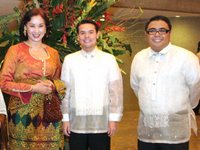 My companion for the evening was our president at the HCS, Gemma Cruz-Araneta. The performances were excellent! But as Gemma noted, the script lacked something, the very essence of the celebrations. That's why in her Manila Bulletin column, Gemma questions this missing element in her piece entitled Woven Amnesia, a play of the English translation of the title Woven Memories since the scriptwriter forgot to present the declaration of independence, the First Philippine Republic and the events of 1898 in the fabric of history symbolically featured.
My companion for the evening was our president at the HCS, Gemma Cruz-Araneta. The performances were excellent! But as Gemma noted, the script lacked something, the very essence of the celebrations. That's why in her Manila Bulletin column, Gemma questions this missing element in her piece entitled Woven Amnesia, a play of the English translation of the title Woven Memories since the scriptwriter forgot to present the declaration of independence, the First Philippine Republic and the events of 1898 in the fabric of history symbolically featured.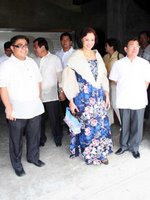 Today was spent in San Fernando to attend the local Independence Day celebrations. I had wanted to attend the reenactment of the 1899 Independence Day celebrations, the first and last Independence Day under the first republic which was held in front of the Pamintuan House in Angeles. But the 7 a.m, calltime was just too early for me and I was still exhausted. Anyway, in San Fernando, our guest of honor and speaker was none other than Gemma who as expected arrived in an exquisite maria clara. Filipinos should really learn to dress for the occasion no matter if the sun is scorching hot.A large parade was arranged by the DepEd with students from each of the 35 barangays of San Fernando presenting tableaus of various historical national and local events on floats. Although I noticed there was a lack of marching bands since the parade was so long and in between bands, there was no music so it looked like a processesion. Hehe! At the Bren Guiao Convention Center, there were thousands of students assembled for the celebrations, watching the parade as it entered the grandstand.
Today was spent in San Fernando to attend the local Independence Day celebrations. I had wanted to attend the reenactment of the 1899 Independence Day celebrations, the first and last Independence Day under the first republic which was held in front of the Pamintuan House in Angeles. But the 7 a.m, calltime was just too early for me and I was still exhausted. Anyway, in San Fernando, our guest of honor and speaker was none other than Gemma who as expected arrived in an exquisite maria clara. Filipinos should really learn to dress for the occasion no matter if the sun is scorching hot.A large parade was arranged by the DepEd with students from each of the 35 barangays of San Fernando presenting tableaus of various historical national and local events on floats. Although I noticed there was a lack of marching bands since the parade was so long and in between bands, there was no music so it looked like a processesion. Hehe! At the Bren Guiao Convention Center, there were thousands of students assembled for the celebrations, watching the parade as it entered the grandstand. The loudest cheers were however given to the vehicle carrying Mikee Lee, first runner-up of the Pinoy Big Brother Teen Edition, who is from San Fernando. Imagine, it was only then that I found out that Mikee was a Cabral from Sta. Lucia, his uncle a former city councilor of San Fernando. His kuya, Peter, was a batchmate at the Ateneo High School and I was telling him that if they highlighted his being a native of San Fernando, the Kapampangans would have given him a solid vote. Hehe! From the cheers, screams, shouts and shrieks of the high school students in the jampacked convention center, I realized the power of television and how one show can change your life overnight. As Peter told me, Mikee was still learning the ropes of stardom and was not used to the adoration. I'm sure!
The loudest cheers were however given to the vehicle carrying Mikee Lee, first runner-up of the Pinoy Big Brother Teen Edition, who is from San Fernando. Imagine, it was only then that I found out that Mikee was a Cabral from Sta. Lucia, his uncle a former city councilor of San Fernando. His kuya, Peter, was a batchmate at the Ateneo High School and I was telling him that if they highlighted his being a native of San Fernando, the Kapampangans would have given him a solid vote. Hehe! From the cheers, screams, shouts and shrieks of the high school students in the jampacked convention center, I realized the power of television and how one show can change your life overnight. As Peter told me, Mikee was still learning the ropes of stardom and was not used to the adoration. I'm sure! After the program, we had lunch at the new city hall site. The aircon was a welcome respite to the scorching heat outside. For the afternoon, Gemma and I went to nearby Guagua and Lubao to check out the municipios for possible inclusion in the calendar.Along the way, we passed by several heritage buildings including the Lopez House in Guagua which were very well-maintained. Gemma was not that satisfied with both municipios. Although they were quite intact, they looked ordinary architecturally speaking.
After the program, we had lunch at the new city hall site. The aircon was a welcome respite to the scorching heat outside. For the afternoon, Gemma and I went to nearby Guagua and Lubao to check out the municipios for possible inclusion in the calendar.Along the way, we passed by several heritage buildings including the Lopez House in Guagua which were very well-maintained. Gemma was not that satisfied with both municipios. Although they were quite intact, they looked ordinary architecturally speaking. In Lubao, we passed by the oldest town church in the province. The retablo was impressive! But sad to say, some priest white-washed the trompe l'oeil murals that once adorned the ceiling. We had wanted to meet with Mayor Dennis Pineda to try to convince him to restore the said murals but he was still incomunicado since the bomb explosion in front of his home. Oh well! Maybe next time when things are a little better. The restoration of those murals would be a very worthwhile project.
In Lubao, we passed by the oldest town church in the province. The retablo was impressive! But sad to say, some priest white-washed the trompe l'oeil murals that once adorned the ceiling. We had wanted to meet with Mayor Dennis Pineda to try to convince him to restore the said murals but he was still incomunicado since the bomb explosion in front of his home. Oh well! Maybe next time when things are a little better. The restoration of those murals would be a very worthwhile project.
It’s been quite a while since I’ve been on a road trip. And today’s itinerary was a spur of the moment decision. Since we needed more photos for the 2007 HCS calendar which would feature capitols, city halls and municipios; and since Gemma said Baliuag has a historical one, I decided to make a detour into northeastern Bulacan on the way back to Manila from Pampanga.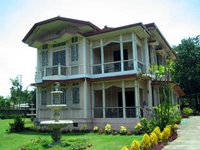 I exited in Pulilan and passed by the town proper (the church is right along the national highway). There were several charming bahay na bato and chalets along the way. Maybe next year I’ll try to watch the Carabao Festival from May 14 to 15, again held in honor of San Isidro Labrador. This festival is also held in San Isidro, Nueva Ecija and Angono, Rizal.
I exited in Pulilan and passed by the town proper (the church is right along the national highway). There were several charming bahay na bato and chalets along the way. Maybe next year I’ll try to watch the Carabao Festival from May 14 to 15, again held in honor of San Isidro Labrador. This festival is also held in San Isidro, Nueva Ecija and Angono, Rizal. From Pulilan, I was off to Baliuag to take a photo of their old municipio which is now a museum. I like the way Baliuag is planned, with a glorieta in the middle of town. The church and convento are well-preserved. In front of the church is a grand monument to Dr. Jose Rizal complete with a pair of sphinxes on either side which is so art deco.
From Pulilan, I was off to Baliuag to take a photo of their old municipio which is now a museum. I like the way Baliuag is planned, with a glorieta in the middle of town. The church and convento are well-preserved. In front of the church is a grand monument to Dr. Jose Rizal complete with a pair of sphinxes on either side which is so art deco.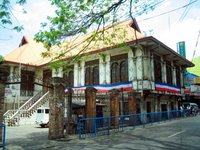 The old municipio is a few meters away along the road to San Miguel. After taking some snapshots, and since I felt like exploring some more, I decided to visit San Miguel de Mayumu since the municipio there was also built during the Spanish colonial period. It however wasn’t the main attraction of the town.I’ve been there several years back and the elegant colonial homes were just splendid! But I was surprised to find many of them in a state of decay, including the three-storey Victorian Cake House which is always featured in coffee table books on Philippine architectural heritage.
The old municipio is a few meters away along the road to San Miguel. After taking some snapshots, and since I felt like exploring some more, I decided to visit San Miguel de Mayumu since the municipio there was also built during the Spanish colonial period. It however wasn’t the main attraction of the town.I’ve been there several years back and the elegant colonial homes were just splendid! But I was surprised to find many of them in a state of decay, including the three-storey Victorian Cake House which is always featured in coffee table books on Philippine architectural heritage.
 There is a twist to the third floor since this was rare in the bahay na bato. According to the story, "a macho farmer married the landowner's daughter. To out-do his father-in-law, the farmer built the tallest house in the area: so that the father, on passing the threshhold, had to look up to his son-in-law! The third level had a massive ballroom where the elite would throw balls as entertainment between sugar crops."
There is a twist to the third floor since this was rare in the bahay na bato. According to the story, "a macho farmer married the landowner's daughter. To out-do his father-in-law, the farmer built the tallest house in the area: so that the father, on passing the threshhold, had to look up to his son-in-law! The third level had a massive ballroom where the elite would throw balls as entertainment between sugar crops." San Miguel is one of the few well-preserved towns which have yet to be declared by the National Historical Institute. Yes, the NHI board has yet to declare San Miguel, Bulacan and many other heritage towns! And while these historians sit down and take their time, many centuries-old homes are going down, taken for granted by the very institution mandated to protect them.
San Miguel is one of the few well-preserved towns which have yet to be declared by the National Historical Institute. Yes, the NHI board has yet to declare San Miguel, Bulacan and many other heritage towns! And while these historians sit down and take their time, many centuries-old homes are going down, taken for granted by the very institution mandated to protect them. How sad it was to see a well-preserved heritage town in such a sorry state. I wonder why the Provincial Government of Bulacan, which I have known to be a staunch advocate of culture and the arts, is allowing these houses to decay and remain in such a state of neglect given that San Miguel’s ancestral homes are among the showcases of the province?
How sad it was to see a well-preserved heritage town in such a sorry state. I wonder why the Provincial Government of Bulacan, which I have known to be a staunch advocate of culture and the arts, is allowing these houses to decay and remain in such a state of neglect given that San Miguel’s ancestral homes are among the showcases of the province?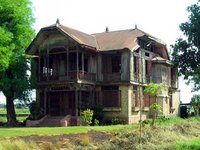 On the way back, I took a photo of the Ilusorio House in San Ildefonso which was along the highway. Aside from its outstanding architectural features, the house stands as a poignant reminder of the horrors of the Second World War where women from an entire barangay (Mapanique, Candaba) were locked and raped repeatedly by their Japanese captors. These wives, mothers and daughters, collectively known as the Malaya Lolas, had lost their husbands, fathers and sons who were tortured and massacred by the Japanese Imperial Army. Sigh!It was also suggested that I pass by San Rafael to check out the old houses. There were some nice ones but not as much as San Miguel. Since I was in San Rafael, might as well visit the church in Angat which was featured in the book of Fathers Javellana and Galende, Great Churches of the Philippines.
On the way back, I took a photo of the Ilusorio House in San Ildefonso which was along the highway. Aside from its outstanding architectural features, the house stands as a poignant reminder of the horrors of the Second World War where women from an entire barangay (Mapanique, Candaba) were locked and raped repeatedly by their Japanese captors. These wives, mothers and daughters, collectively known as the Malaya Lolas, had lost their husbands, fathers and sons who were tortured and massacred by the Japanese Imperial Army. Sigh!It was also suggested that I pass by San Rafael to check out the old houses. There were some nice ones but not as much as San Miguel. Since I was in San Rafael, might as well visit the church in Angat which was featured in the book of Fathers Javellana and Galende, Great Churches of the Philippines. The exterior was charming! But the interior was just shocking, an excessive use of gold leaf! Just to make things clear, what was done inside the Angat Church was a renovation and not a restoration. For it to be a restoration, it must approximate the original interior of the church.The new ceiling murals were just too loud and modern for the old colonial charm of this church. As I told a friend (the one who did the interior was also a friend), you don’t put opulence when it was previously not there. In fact, the elegance of the Angat Church was in its simplicity, now erased by a rampage of gold leaf.One must not impose his style on an old church. That goes for priests, parish pastoral councils and the architects and interior designers they hire to renovate them, who most of the time go overboard with decorations and details. We must leave old churches as they are because these are testaments to the craftsmen and artisans who designed them.Additions should not overpower the original design. I wonder how these architects and interior designers would feel if a hundred years from now, their works would be eradicated by future architects and interior designers who like them impose their style on previous masterpieces.Anyway, enough said. From Angat, it was off to Manila. I took the longer, more scenic route via Norzagaray. The foothills of the Sierra Madre offered a relaxing view. But there were eyesores as well, quarrying plants and their towering machinery. Sigh! The drive was quite long thanks to the slow traffic as I neared Metro Manila. It would take me to San Jose del Monte City, North Caloocan and finally, Fairview where traffic management was horrible! Mayor Belmonte should fire his traffic enforcers and ban undisciplined jeepney drivers. Hmmmm... there wouldn't be any jeeps left then! Hehe! I had driven a total of seven hours! And now it's time for me to rest.
The exterior was charming! But the interior was just shocking, an excessive use of gold leaf! Just to make things clear, what was done inside the Angat Church was a renovation and not a restoration. For it to be a restoration, it must approximate the original interior of the church.The new ceiling murals were just too loud and modern for the old colonial charm of this church. As I told a friend (the one who did the interior was also a friend), you don’t put opulence when it was previously not there. In fact, the elegance of the Angat Church was in its simplicity, now erased by a rampage of gold leaf.One must not impose his style on an old church. That goes for priests, parish pastoral councils and the architects and interior designers they hire to renovate them, who most of the time go overboard with decorations and details. We must leave old churches as they are because these are testaments to the craftsmen and artisans who designed them.Additions should not overpower the original design. I wonder how these architects and interior designers would feel if a hundred years from now, their works would be eradicated by future architects and interior designers who like them impose their style on previous masterpieces.Anyway, enough said. From Angat, it was off to Manila. I took the longer, more scenic route via Norzagaray. The foothills of the Sierra Madre offered a relaxing view. But there were eyesores as well, quarrying plants and their towering machinery. Sigh! The drive was quite long thanks to the slow traffic as I neared Metro Manila. It would take me to San Jose del Monte City, North Caloocan and finally, Fairview where traffic management was horrible! Mayor Belmonte should fire his traffic enforcers and ban undisciplined jeepney drivers. Hmmmm... there wouldn't be any jeeps left then! Hehe! I had driven a total of seven hours! And now it's time for me to rest.
 The first stop on the itinerary was the town of Sto. Domingo, the hometown of Sarung Banggi composer Potenciano V. Gregorio. They have a nice church, the Sto. Domingo de Guzman Church, with two symmetrical bell towers on both sides of the facade. This was compeleted sometime in 1832. Sad to say, entering the church was a disappointment, since it was renovated as always. Oh those priests! They like leaving their mark no matter how ugly! It was a pity since the facade was quite charming.
The first stop on the itinerary was the town of Sto. Domingo, the hometown of Sarung Banggi composer Potenciano V. Gregorio. They have a nice church, the Sto. Domingo de Guzman Church, with two symmetrical bell towers on both sides of the facade. This was compeleted sometime in 1832. Sad to say, entering the church was a disappointment, since it was renovated as always. Oh those priests! They like leaving their mark no matter how ugly! It was a pity since the facade was quite charming. From Sto. Domingo, we moved to the next town Bacacay and the Sta. Rosa de Lima Church. Again, this nice church was renovated inside. Sigh! Right beside it were ruins of an older church and one could still recognize some of its features.
From Sto. Domingo, we moved to the next town Bacacay and the Sta. Rosa de Lima Church. Again, this nice church was renovated inside. Sigh! Right beside it were ruins of an older church and one could still recognize some of its features. We were then off to Tabaco City which is home to the only national cultural treasure in Bicol, the San Juan Bautista Church. I wonder why the National Museum even considered this church a national cultural treasure. Except for its massive belfry which I must admit is quite an impressive work of art and engineering, the rest of it has been altered just like every other church I've been to in Albay. I wonder how this trend started. But it was sad entering every church seeing the interiors altered.
We were then off to Tabaco City which is home to the only national cultural treasure in Bicol, the San Juan Bautista Church. I wonder why the National Museum even considered this church a national cultural treasure. Except for its massive belfry which I must admit is quite an impressive work of art and engineering, the rest of it has been altered just like every other church I've been to in Albay. I wonder how this trend started. But it was sad entering every church seeing the interiors altered. The facade of the Tabaco Church itself has new oversized stained glass windows. While the old santos in the retablos have been replaced by new ones. If you were to ask me, the candidates for national cultural treasure in Albay should have been the churches in Daraga or Camalig. Oh well!
The facade of the Tabaco Church itself has new oversized stained glass windows. While the old santos in the retablos have been replaced by new ones. If you were to ask me, the candidates for national cultural treasure in Albay should have been the churches in Daraga or Camalig. Oh well! We then checked out the city hall which I had travelled so far to see. I wasn't quite pleased with what I saw. Indeed, it is the most well-preserved municipio in Albay, but there was so much clutter because of ongoing basketball competitions, the entire perimeter fence was covered with galvanized iron sheets maybe because they charged entrance to the games and with the cover, bystanders could not watch. We were also told it was Spanish colonial. But it turns out, the city hall was built during the American colonial period, very typical of town buildings during that time. Oh well, so much for that calendar photo.
We then checked out the city hall which I had travelled so far to see. I wasn't quite pleased with what I saw. Indeed, it is the most well-preserved municipio in Albay, but there was so much clutter because of ongoing basketball competitions, the entire perimeter fence was covered with galvanized iron sheets maybe because they charged entrance to the games and with the cover, bystanders could not watch. We were also told it was Spanish colonial. But it turns out, the city hall was built during the American colonial period, very typical of town buildings during that time. Oh well, so much for that calendar photo. From there it was off to Tiwi. Looking at the pictures, I was expecting a very quaint church. But we got the shock of our lives when we arrived there since it was currently undergoing uglification! They were plastering the adobe with a layer of cement and were beginning to contruct an oversized portico in front of the church which would completely ruin the facade!
From there it was off to Tiwi. Looking at the pictures, I was expecting a very quaint church. But we got the shock of our lives when we arrived there since it was currently undergoing uglification! They were plastering the adobe with a layer of cement and were beginning to contruct an oversized portico in front of the church which would completely ruin the facade! From Tiwi, it was a long drive to Libon which was on the other side of Albay. Nothing much left there, not even an old church, which is a pity because this used to be Villa Santiago de Libon, the fourth villa established by the Spaniards in the archipelago. We then drove to Polangui, Oas and Ligao City. The next stop was Guinobatan. And on the way, we stopped along the road to buy a snack, a very popular delicacy known as macapuno rice puto which was two layers of puto, one purple and one white with a rich macapuno filling in the center. Yummy!
From Tiwi, it was a long drive to Libon which was on the other side of Albay. Nothing much left there, not even an old church, which is a pity because this used to be Villa Santiago de Libon, the fourth villa established by the Spaniards in the archipelago. We then drove to Polangui, Oas and Ligao City. The next stop was Guinobatan. And on the way, we stopped along the road to buy a snack, a very popular delicacy known as macapuno rice puto which was two layers of puto, one purple and one white with a rich macapuno filling in the center. Yummy! Anyway, Guinobatan struck me because of the colorfully painted municipio, church and monuments, very typical of structures at that time. We just don't realize it because photos are in black and white but facades of buildings during the Spanish and American colonial periods used to be colored quite lively.
Anyway, Guinobatan struck me because of the colorfully painted municipio, church and monuments, very typical of structures at that time. We just don't realize it because photos are in black and white but facades of buildings during the Spanish and American colonial periods used to be colored quite lively. Inside, the ceiling still has its original murals but sad to say the floor had been raised by over a meter covering the original clay tile floor. The altar also has modern santos. I wonder which house in Forbes Park has most of the centuries-old Albay santos. Hehe!
Inside, the ceiling still has its original murals but sad to say the floor had been raised by over a meter covering the original clay tile floor. The altar also has modern santos. I wonder which house in Forbes Park has most of the centuries-old Albay santos. Hehe! Seeing majestic Mayon even for the second time was most worth the long hours on the road. Its nearly perfect cone towers over the landscape in Albay and is a part of life there. I hope the Bicolanos are able to maintain the beauty of their natural heritage, especially Mayon, because indeed, these are treasures.
Seeing majestic Mayon even for the second time was most worth the long hours on the road. Its nearly perfect cone towers over the landscape in Albay and is a part of life there. I hope the Bicolanos are able to maintain the beauty of their natural heritage, especially Mayon, because indeed, these are treasures. Daraga Church is indeed a sight to behold with its very elaborate facade. As I mentioned earlier, if there should have been a national cultural treasure, it should be this church with its elaborately-decorated facade. But the interior is as modern as it can get an this may explain why the National Museum no longer considered the church. Only the baptistry (below) has remnants of the previous interior and you can see from the carvings on the wall, the remaining patches of paint, and the blue ceramic tiles on the floor that the inside was equally elaborate as well.
Daraga Church is indeed a sight to behold with its very elaborate facade. As I mentioned earlier, if there should have been a national cultural treasure, it should be this church with its elaborately-decorated facade. But the interior is as modern as it can get an this may explain why the National Museum no longer considered the church. Only the baptistry (below) has remnants of the previous interior and you can see from the carvings on the wall, the remaining patches of paint, and the blue ceramic tiles on the floor that the inside was equally elaborate as well. We were told that a former parish priest had the interior renovated and even sold many of the priceless antiques to fund the said uglification. Horrible this priests who leave a mark by wasting church money, selling off priceless works of art which end up in private homes most of the time to pay for useless and ugly renovations so that they will be remembered.
We were told that a former parish priest had the interior renovated and even sold many of the priceless antiques to fund the said uglification. Horrible this priests who leave a mark by wasting church money, selling off priceless works of art which end up in private homes most of the time to pay for useless and ugly renovations so that they will be remembered. It was 5 p.m. and I realized I had visited almost every town in Albay in a span of nine hours! I had enough for the day and it was back to the guesthouse. After a brief nap, I took a jeep to the center of the Old Albay District (downtown Legazpi is called the Port District) to have some dinner. I could not resist the isaw which was sold all over the place. Again, I had Bicol express. But this time, it was spicy! After checking mail, it was off to bed since I was tired and I had a long day ahead of me tomorrow.
It was 5 p.m. and I realized I had visited almost every town in Albay in a span of nine hours! I had enough for the day and it was back to the guesthouse. After a brief nap, I took a jeep to the center of the Old Albay District (downtown Legazpi is called the Port District) to have some dinner. I could not resist the isaw which was sold all over the place. Again, I had Bicol express. But this time, it was spicy! After checking mail, it was off to bed since I was tired and I had a long day ahead of me tomorrow.













